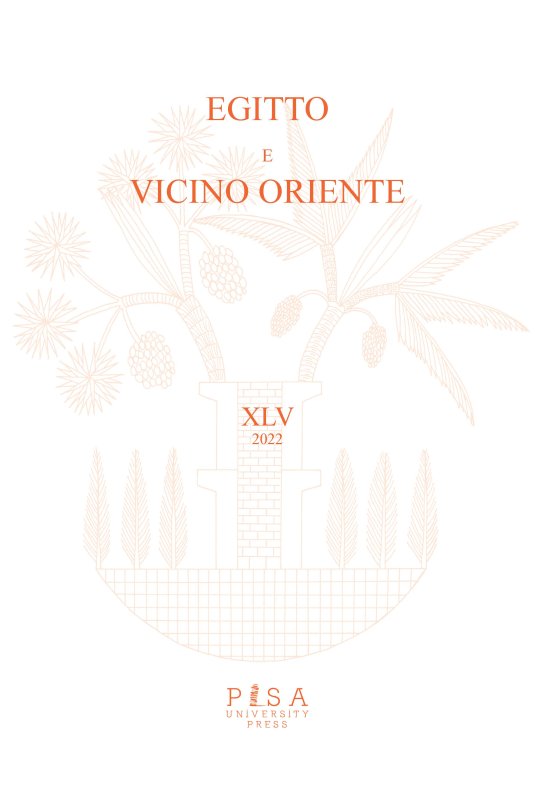
The contribution provides three notes on Middle Kingdom objects in British Collections. A copy of the inscriptions on the statue of queen Senet (the Royal Collections RCIN 7817) is provided. The article links a door lintel found at Abydos (now Bristol Museum & Art Gallery, H 521) with a door jamb now in Uppsala (The Victoria Museum for Egyptian Antiquities, VM 1950) and provides a short discussion of the woman’s title zemat-Hor. The door lintel Fitzwilliam Museum Cambridge SS.46 is published for the first time with a photographic image.
The formulas Ḥr sp-sn wꜣḏ Sḫm.t ḥꜣ iwf NN tm n ʾnḫ and sꜣ ḥꜣ sꜣ ii sꜣ are two recognizable parts of several ancient Egyptian magical texts, mainly spells against demons and ghosts. They usually recur at the end of the spell, almost like a ritual refrain. Their existence spans from the Middle Kingdom to the Graeco-Roman Period, with minimal changes. The formula Ḥr wꜣḏ Sḫm.t aims to protect the person specifically from demons related to the goddess Sekhmet, while the formula sꜣ ḥꜣ sꜣ is the evolution of an expression of protection already present in the Middle Kingdom Apotropaia. The two formulas present several common aspects that help identify them as “amuletic formulas”, that is to say, written formulas that stand for amulets through the emblematic value of hieroglyphic writing. The present paper aims at analysing the multi-layered nature of these formulas, whose words refer to complex religious and symbolic meanings that are conveyed and objectified by the written word.
Identifying and contextualising the remains of the so-called Kerma culture north of the Third Cataract remains a major challenge in Middle Nile archaeology (modern Sudan). Previous studies have focused on major centres like Sai and cemeteries in the Batn el-Haggar region. In recent years, the problems associated with a rudimentary understanding of Nubian cultures and a biased view of Nubian-Egyptian relations have been increasingly addressed. Regional studies, such as this one focusing on the hinterland of the Kerma kingdom’s northern stronghold at Sai, hold great potential for achieving a more realistic understanding of the complex social dynamics and cultural interactions in the Bronze Age (focusing on c. 1800-1200 BCE).
The aim of this paper is to present the preliminary excavation results of a large Kerma cemetery on the outskirts of Sai, which was continuously used from Middle Kerma to Classic Kerma times and has close parallels to cemeteries in Batn el-Haggar. The new excavations provide a better understanding of rural Kerman funerary practices and the types of imported objects that are present or missing within these communities, demonstrating local prosperity and the superregional interconnectedness of these groups.
The harvest scene in the Theban tomb chapel of Ineni (TT 81) differs from other New Kingdom renderings of the same motif in the way in which the spatial relations are represented. This observation forms the starting point for a closer look at this scene from three different hermeneutic angles. First, possible reasons for the pictorial solution chosen by the creator(s) of Ineni’s harvest scene are presented. Subsequently, the possibility that this scene has been inspired by similar cases from the Old Kingdom is examined. Finally, an unexpected medieval parallel serves as a reminder of the fact that very similar pictorial solutions can be found independently and repeatedly.
During the excavations at Central Dra’ Abu el-Naga (CDAN), numerous objects and tomb assemblages were unearthed including the funerary cones. A number of cones were associated either with tombs in Dra’ Abu el-Naga (DAN) or tombs in other places in the Theban Necropolis. This article will shed light on three burial cone types that, according to the author, were previously unknown and had not been identified in the work of Davies/Macadam, Daressy, nor the Marquis of Northampton.
The subject of this article is a group of floral garlands belonging to Schweinfurth’s collection and donated to the Rijksmuseum van Oudheden in Leiden in the 1880s, which includes portions of the garlands of Ramses II. The results of the observations conducted on these objects in 2020 are presented here. Particular attention is paid to the identification of the species used, as well as to their manufacture. The results are then discussed with the comparison of other portions of the same garlands today divided among numerous museums.
The conclusions shed light on some new identification (such as the doum palm), on the usefulness of some details of the manufacture as possible revealers of the context and time of production, and, more generally, on the need for an accurate description in the publication of this type of material.
This paper aims at presenting two objects from the ancient Collection of Giampiero Guerreschi, which are now kept in the Egyptian Section of the Museum of Crema (Italy), namely a Late Period shabti inscribed in the name of Psamtekdinet, son of Hormes (inv. 2510) and a Third Intermediate Period polychrome cartonnage coffin fragment which depicts Osiris sitting on a throne (inv. 2511).
This article presents a heterogeneous group of objects found in the shafts no. 10 and 18 of the tomb of Khunes during an archaeological survey at Zawyet Sultan. The items under discussion can be grouped in three broad typological categories: copper alloy figurines, faience
amulets, and funerary equipment. As none of these objects were found in primary archaeological contexts, it is impossible to determine their original provenance. The analysis of the artefacts shows that they belong to a broad but defined timeframe, ranging from the Late to
the Ptolemaic Period. This paper aims to present data for all of the objects found in the shafts no. 10 and 18 of the tomb of Khunes and to identify parallels in other collections, in order to show and compare artefacts of the people who lived at ancient Hebenu. This specifically concerns the artefacts from previous excavations at Zawyet Sultan by Raymond Weill, now preserved at the Louvre Museum in Paris and the Joseph-Denais Museum in Beaufort en-Vallée.
Egyptian mythological concepts varied to a degree depending on local specifics. As an example, the part on the five sons of Bastet in the section on Bubastis in pBrooklyn 47.218.84 is analyzed. It is compared to the “standard” version of the Osiris myth, which it presupposes.
It is demonstrated how such local versions differed among each other. Of particular interest is one of the stories in pBrooklyn 47.218.84, as it explains the mythical origins of the Near Eastern god Hauron from an Egyptian perspective.
The finding of few animal-shaped vessels among the assemblage of Late Antique pottery from the monastery of Manqabad posed the question of what meaning and function this typology could have had in the framework of the Christian rituals performed at the site. Therefore, a documentation and study of two vessels related to specific animals (a fish and a sow) has been conducted, in order to clear their main characteristics and suggest a possible use of these items, rarely object of systematic study.
This paper will present an unpublished document, kept in the Biblioteca Labronica in Livorno, that corresponds to a list of Egyptian antiquities arrived in the free port of the Tuscan city in 1825. Thanks to a comparation with other archival data, the inventory turns out to be the Italian translation of the original catalogue of the Second Collection of Henry Salt, now in the Louvre Museum, perhaps written by the British Consul General in Egypt himself. The main aim of the article is thus to identify the objects described in the Inventario, recognizing them in the current heritage of the Parisian museum. In addition, every possible source about the history of the document will be analysed.
A number of Egyptian women appear in a private archive from the Assyrian city of Assur as investors in trade enterprises. This brief study focuses on these women, their economic dealings, and on their relative social positions as indicated by the archive. The evidence shows that Egyptian women could enjoy a relative legal-economic freedom also in their Assyrian exile.
Anna Maria Pastorino, Guido Rossi, Le lastre assire del Museo di Archeologia Ligure, nuovi dati
Since 1892, the Municipality of Genoa has had on deposit from the University Library of Genoa two figured bas-reliefs and a cuneiform inscription, now in the Museo Civico di Archeologia Ligure of Genoa. These pieces have been exhibited and studied on several occasions until the most recent editions in the 1990s for the exhibition “Dai Palazzi Assiri”.
The recent discovery of a letter in the archives of the University Library of Genoa makes it possible to date more precisely the acquisition of the plates by the missionary Luigi di Negro, who was active in Mesopotamia around the middle of the 19th century, his possible
relationships with the excavation teams active in the area at that time, but above all, it makes it possible to clarify both the way the pieces were found and their precise location: the royal palaces of Khorsabad and Nineveh.
Over the last few years the Chinese porcelain found in ports and urban centres involved in inter-Asian trade along the Indian Ocean routes, together with material from the wrecks of merchant ships and collections, has offered ample evidence for the study of the cultural, economic and social relations between the various entities involved in this network of commercial and diplomatic exchanges. This is particularly true for the period preceding the advent of the European powers along these routes and their subsequent predominance as from the 16th century. It is a period that is increasingly being studied with a view to re-evaluation of the globalisation processes in the ancient world. Here, the Chinese porcelain represents material evidence which we can, without the least exaggeration, define as incomparable. In fact, the origins of and trade in raw materials and technologies, the hybridisation of decorative motives and forms, and the wide-ranging diffusion and re-elaboration of practices and meanings associated with Chinese porcelain and stoneware, attest to intercultural dynamics and a global or, better, glocal utilisation of these materials.
In the broader context of relations between China and the Arabian Peninsula, few sites offer such a rich and significant assemblage as the settlement of al-Balīd (ancient Ẓafār), and few sites offer such remarkable leads for analysis of the connections between production, reception and use of Chinese porcelain during the Islamic period. This article focuses particularly on the period between 1279 and 1435, which saw the trade between China and Arabia, together with the consumption and impact of Chinese porcelain on the southern coast of the Arabian Peninsula, at its most flourishing.
The article deals with the Qatabanic term tqnt occurring in the royal edict CSAI I, 197=R 3688, 5. The recently proposed interpretation “goods” is further confirmed by some parallels in Northwest Semitic. In particular, the comparison with the term teqnītu occurring in the Old Babylonian legal documents from Alalakh is noteworthy. A possible riconstruction of the morphological nominal pattern of tqnt is also provided.
The exhibition Arts from the Land of Timur held at Bonhams Auction House (Edinburgh, January 2013) features an astonishing number of medieval art pieces, many of which are from the Semirechye region (Kyrgyzstan and Kazakhstan). Information regarding the origin of the pieces is lacking, and almost all objects are described as “unpublished”. This brief note provides information on Item N. 209, a Nestorian gravestone, which was first published in 2000 and again in 2010, and suggests a more precise reading of its Syriac epitaph.
